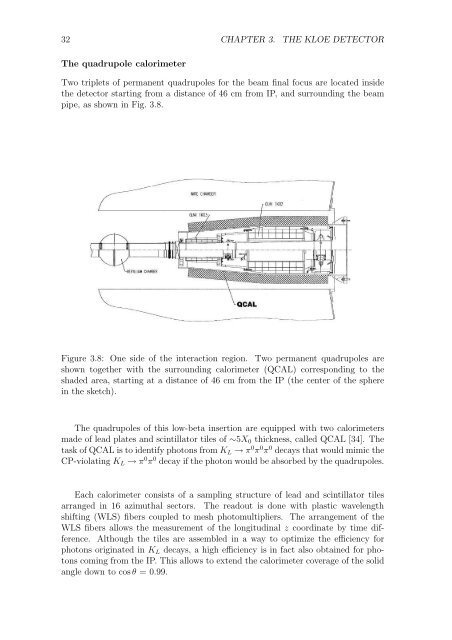Universit`a degli studi Roma Tre Measurement of the KL meson ...
Universit`a degli studi Roma Tre Measurement of the KL meson ...
Universit`a degli studi Roma Tre Measurement of the KL meson ...
You also want an ePaper? Increase the reach of your titles
YUMPU automatically turns print PDFs into web optimized ePapers that Google loves.
32 CHAPTER 3. THE <strong>KL</strong>OE DETECTOR<br />
The quadrupole calorimeter<br />
Two triplets <strong>of</strong> permanent quadrupoles for <strong>the</strong> beam final focus are located inside<br />
<strong>the</strong> detector starting from a distance <strong>of</strong> 46 cm from IP, and surrounding <strong>the</strong> beam<br />
pipe, as shown in Fig. 3.8.<br />
Figure 3.8: One side <strong>of</strong> <strong>the</strong> interaction region. Two permanent quadrupoles are<br />
shown toge<strong>the</strong>r with <strong>the</strong> surrounding calorimeter (QCAL) corresponding to <strong>the</strong><br />
shaded area, starting at a distance <strong>of</strong> 46 cm from <strong>the</strong> IP (<strong>the</strong> center <strong>of</strong> <strong>the</strong> sphere<br />
in <strong>the</strong> sketch).<br />
The quadrupoles <strong>of</strong> this low-beta insertion are equipped with two calorimeters<br />
made <strong>of</strong> lead plates and scintillator tiles <strong>of</strong> ∼5X0 thickness, called QCAL [34]. The<br />
task <strong>of</strong> QCAL is to identify photons from <strong>KL</strong> → π 0 π 0 π 0 decays that would mimic <strong>the</strong><br />
CP-violating <strong>KL</strong> → π 0 π 0 decay if <strong>the</strong> photon would be absorbed by <strong>the</strong> quadrupoles.<br />
Each calorimeter consists <strong>of</strong> a sampling structure <strong>of</strong> lead and scintillator tiles<br />
arranged in 16 azimuthal sectors. The readout is done with plastic wavelength<br />
shifting (WLS) fibers coupled to mesh photomultipliers. The arrangement <strong>of</strong> <strong>the</strong><br />
WLS fibers allows <strong>the</strong> measurement <strong>of</strong> <strong>the</strong> longitudinal z coordinate by time difference.<br />
Although <strong>the</strong> tiles are assembled in a way to optimize <strong>the</strong> efficiency for<br />
photons originated in <strong>KL</strong> decays, a high efficiency is in fact also obtained for photons<br />
coming from <strong>the</strong> IP. This allows to extend <strong>the</strong> calorimeter coverage <strong>of</strong> <strong>the</strong> solid<br />
angle down to cosθ = 0.99.
















